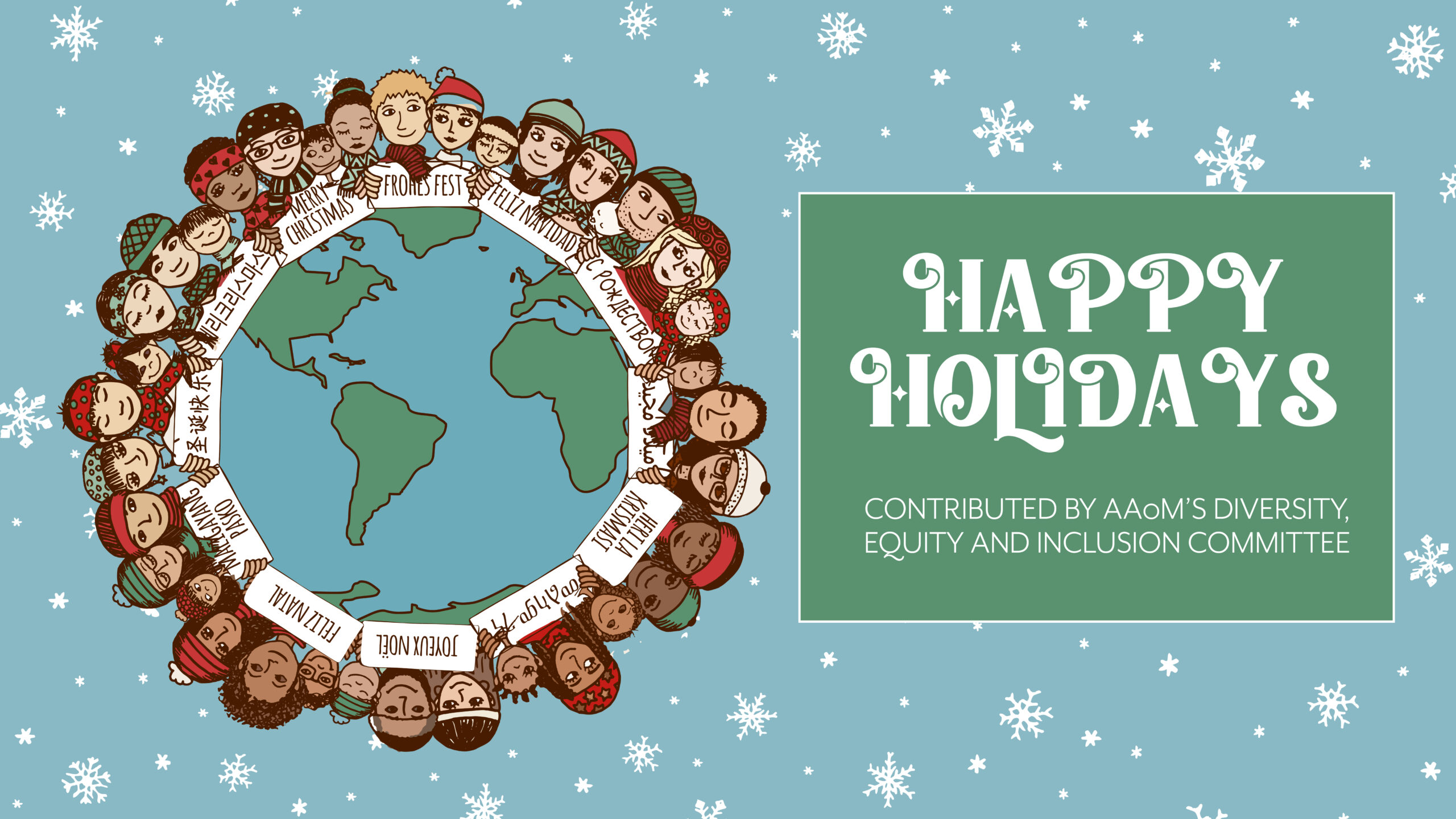Contributed by AAoM’s Diversity, Equity and Inclusion Committee
This holiday season we want to highlight just a few of the many celebrations and traditions that take place this time of year. Plus, we give tips on how you can have a sensory-friendly holiday for yourself or your loved ones.
Hanukkah | December 18-26
For eight days and nights, Jewish people around the world celebrate Maccabees’s victory over King Antiochus, who forbade Jews to practice their religion. The dates of Hanukkah change because this holiday follows the lunar cycle but it typically falls sometime in December. Hanukkah is celebrated for eight nights with prayer, the lighting of the menorah, and food. Families also celebrate by playing games, singing songs, and exchanging gifts. Potato pancakes, known as latkes in Yiddish, are traditionally associated with Hanukkah and are served with applesauce and sour cream.
Kwanzaa | December 26
Kwanzaa is a holiday created by Dr. Maulana Karenga to celebrate African heritage and culture. Celebration entails gathering with family and friends to exchange gifts and light a series of black, red, and green candles. These candles symbolize the seven basic values of African American family life: unity, self-determination, collective work and responsibility, cooperative economics, purpose, creativity, and faith. It also includes a feast of faith, called Karamu Ya Imani.
Diwali | October 24th
Diwali is a five-day festival celebrated in the fall by Hindus, Sikhs, and Jains around the world, however it holds a different meaning and significance for each of the areas and religions that celebrate it. While there are some differences among the groups that celebrate it, Diwali does hold one common symbolism to them all – the triumph of good over evil and light over darkness. Families celebrate by illuminating their homes using clay or oil lamps and creating intricate designs made from rice or flour in front of doorways or shrines.
Las Posadas | December 16-24
In Mexico (and some parts of the U.S.) you can find people celebrating Las Posadas between December 16 and December 24. Families celebrate the journey of Mary and Joseph to Bethlehem. Each evening during the festival, a child dressed like an angel leads a procession through the streets of the town. The festival culminates with a beautiful feast at the Cena de Noche Buena (Christmas Eve Dinner). Some of the traditional dishes include romeritos (baked shrimp), bacalao (dried cod fish), roast turkey, salad, and mounds of sweet and sugary buñuelos. You can also find families in Guatemala and parts of the Southwestern United States celebrating Las Posadas
Chinese New Year
The Chinese New Year is possibly the most important of the traditional Chinese holidays. It falls on different dates each year, sometime in January or February, depending on the lunar calendar. This celebration lasts for about 15 days, and although celebrated in winter, it is also called the Spring Festival because it marks the end of the coldest part of the year. Marking this holiday involves going home to be with your friends and family. Celebrators hang decorations in red, the traditional color of the holiday, and give gifts wrapped in red packages. Chinese New Year celebrations include traditional dances, fireworks, and elaborate parades.
Tips for a Sensory-Friendly Holiday
Keep It Comfy
You can reduce stress by dressing comfortably for holiday events. Wear familiar clothing to eliminate any possibility of sensory issues. If possible, find out the menu beforehand and maybe bring a dish that you’re comfortable with so you don’t have to choke down some gross food that your Aunt made. Strategically sit near family members and friends who you feel comfortable around to avoid getting overwhelmed.
Avoid Stress and Surprises
Though the holiday season sees many changes in routine, try to stick to the regular schedule when possible. Know who to avoid at holiday events. Certain family members can add stress to your holiday, do your best to avoid them. Prepare for the environment of holiday events and have plans in place to mitigate stress.
Pack a Stress Relief Bag
Pack a bag with fun and familiar items to help reduce anxiety. Books, toys and games are good to keep close in case you get overwhelmed and need to sneak away to relax or occupy your mind. Each person relieves stress in a different way so know what works and plan to have it on hand when stress inevitably arises.
Find a Quiet Place to Escape
The holidays often find you in external or unfamiliar environments. Identify a place to escape to when the holidays get overwhelming. Find a room where you can sneak away, go for a walk outside or slip into the basement to have a moment of quiet.
Practice Patience and Go With the Flow
Expect the unexpected and you won’t be disappointed. Go easy on yourself and do your best, you can only plan and control so much so do what you can. If you are a parent, maybe set aside goals and lessons and just let your child focus on getting through the holidays and having fun however they can.
References and Helpful Links:
https://spoken-here.com/language-services/winter-holidays-around-the-world/
https://www.jcfs.org/blog/tips-sensory-friendly-holiday
https://dfwchild.com/how-to-holidays-with-children-who-have-special-needs/
https://the-art-of-autism.com/5-tips-for-surviving-the-holiday-season-from-an-adult-on-the-autism-spectrum/ (From Ron Sandison, our GR Conference Speaker)

